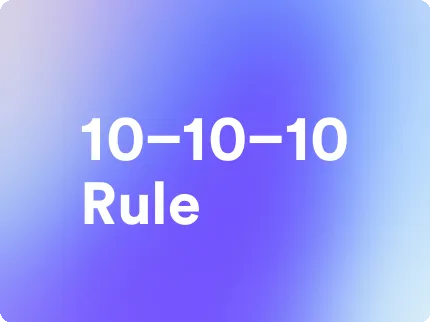The 10–10–10 Rule: A Guide to Better Decision-Making and Productivity
This guide will walk you through the essential elements of using 10–10–10 rule - the productivity method to keep your team productive and engaged.
Try Lark for Free
The 10–10–10 rule is a valuable framework that can revolutionize decision-making and enhance productivity. By evaluating the consequences of our choices over different timeframes, this rule enables individuals to make well-informed decisions while optimizing their long-term outcomes. In this comprehensive guide, we will delve into the origins, applications, and benefits of the 10–10–10 rule, providing actionable insights to assist individuals in incorporating this principle into their daily lives.
Introduction to the 10–10–10 Rule
The 10–10–10 rule is a transformative approach that involves examining the potential impact of our decisions over distinct time horizons. When faced with choices, individuals are encouraged to consider the effects of their decisions over the next 10 minutes, 10 months, and 10 years. By embracing this strategy, individuals can gain valuable insights into the short-term and long-term ramifications of their actions, thereby fostering clarity, foresight, and improved decision-making.
History and Origin
The history and origin of the 10–10–10 rule can be traced back to renowned author and motivational speaker, Suzy Welch. In her 2009 book "10-10-10: A Life-Transforming Idea," Welch introduced this concept as a method to navigate life's complexities. By reflecting on the potential consequences of decisions across various timeframes, Welch's rule emphasizes the critical significance of considering the long-term implications of our choices, guiding individuals towards thoughtful and purposeful decision-making.
Use Lark to unleash your team productivity.
Target Audience
The 10–10–10 rule is applicable to a diverse audience, including professionals, students, entrepreneurs, and homemakers. While its principles can be universally adopted, specific demographics that stand to benefit from this rule include:
- Professionals: Individuals in various industries seeking to enhance their strategic decision-making skills.
- Students: Those navigating academic choices and career pathways can gain clarity from applying this rule to their decision-making processes.
- Entrepreneurs: Business leaders and aspiring entrepreneurs can effectively utilize this strategy to navigate critical business decisions.
Advantages and Disadvantages
Advantages
The 10–10–10 rule offers numerous advantages, including:
- Clarity and Perspective: By systematically evaluating the short-term and long-term effects of decisions, individuals can gain a comprehensive understanding, fostering clarity and enhanced perspective.
- Improved Decision-Making: This framework empowers individuals to make well-informed decisions, as they consider the broader implications of their choices, leading to more favorable outcomes.
Disadvantages
- Potential Overthinking: In certain cases, prolonged contemplation of decisions over various timeframes might lead to overthinking, potentially hindering swift decision-making in time-sensitive scenarios.
- Emotional Factors: The rule may overlook the emotional and psychological aspects of decision-making, which are essential in certain contexts.
Learn more about Lark x Productivity
Getting Started
Embarking on the journey of implementing the 10–10–10 rule involves a series of fundamental steps that can facilitate its integration into one's decision-making process:
- Recognizing the Decision or Task: Identify the specific decision or task that requires examination using the 10–10–10 rule.
- Assessing Short-Term Impact: Consider the consequences of the decision within the next 10 minutes, focusing on immediate effects and implications.
- Evaluating Medium-Term Impact: Extend the evaluation to encompass the impact over the next 10 months, acknowledging the potential ripple effects and challenges that may unfold.
- Anticipating Long-Term Ramifications: Expand the assessment to project the impact over the next 10 years, gaining insight into the broader and enduring consequences of the decision.
Use Lark to unleash your team productivity.
Examples
Example 1: Decision-Making
Example 1: Decision-Making
When faced with a career-defining choice, such as accepting a new job offer, the application of the 10–10–10 rule can offer profound insights. By contemplating the short-term, mid-term, and long-term ramifications of the decision, individuals can make informed choices that align with their career aspirations and life goals.
Tips for Do's and Don’ts
| Do's | Dont's |
|---|---|
| Take time to reflect on the long-term effects of a decision | Avoid rushing through the evaluation process |
| Seek trusted counsel and advice from mentors or advisors | Neglect considering the short-term implications |
| Prioritize clarity and perspective when assessing options | Disregard the emotional or immediate consequences |
| Maintain a balanced approach between short-term and long-term perspectives | Overlook the potential risks associated with a decision |
Conclusion
In conclusion, the 10–10–10 rule offers a compelling framework for individuals to navigate decision-making and improve productivity. By consciously evaluating the consequences of choices across distinct timeframes, individuals can cultivate foresight and make choices that are congruent with their long-term aspirations and values.
Use Lark to unleash your team productivity.
